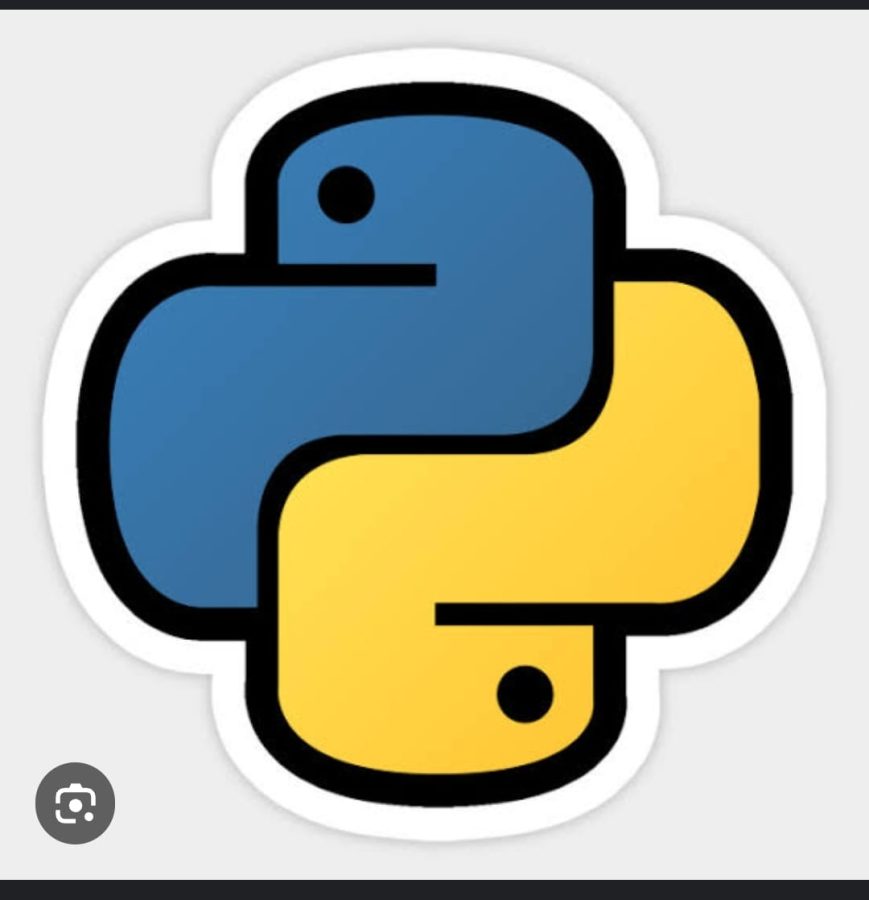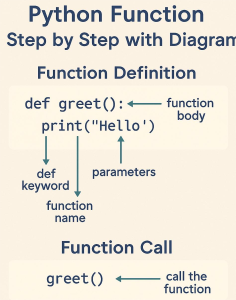Step 1: What is a Python Function ?
A Python Function is a named block of code designed to perform a specific task.
Instead of writing repetitive lines of code, you define the logic once in a function and reuse it by “calling” the function whenever needed. This makes your code:
-
Shorter
-
Easier to read
-
Easier to debug
-
Modular
In short: Functions help you write clean and efficient code.
Step 2: Syntax of a Python Function
The basic syntax to define a function in Python is:
python
def function_name(parameters):
# Function body
return value
Let’s break it down::
-
def: This keyword is used to define a function. -
function_name: The name you assign to the function. -
parameters: (optional) Inputs to the function. -
return: (optional) The output you want to send back.
You can define functions with or without parameters and with or without return values.
Step 3: Creating and Calling a Function
Let’s define a simple function to greet a person:
python
def greet(name): print (hello, {name}!")
Now we call the function like this:
python
greet("Alice") # Output: Hello, Alice!
Here:
-
"Alice"is the argument -
nameis the parameter -
greet()is the function being called
Step 4: Diagram – How a Function Works
SQL
Main Program
|
| Call: greet("Alice")
v
+-------------------------+
| def greet(name): | <-- Function Definition
| print ("Hello", name) |
+-------------------------+
|
v
+----------------------------+
| Output: Hello, Alice! |
+----------------------------+
This diagram helps visualize:
-
How control flows from the main code to the function
-
How arguments are passed
-
How the function executes and returns control
Step 5: Parameters vs Arguments
These two terms are often confused.
-
Parameters: Variables listed inside the parentheses in the function definition.
-
Arguments: The actual values passed when calling the function.
Example:
python
def add (a, b): # a, b are parameters
return a + b print (add (5, 3)) # 5, 3 are arguments
default parameters:
python
def greet(name="Guest"): print (hello, {name}!") greet () # Output: Hello, Guest
greet("Ravi") # Output: Hello, Ravi
Step 6: Using the return Statement
The return statement is used to send a result back to the caller.
python
def square(n):
return n * n
You can also return multiple values:
python
def calc (a, b):
return a + b, a * b
print(sum_) # Output: 7
prints(product) # Output: 10
If you don’t use return, the function returns None.
Step 7: Types of Functions
1. Built-in Functions
Predefined functions like:
python
print(), len(), type(), int(), float(), input()
2. User-defined Functions
Custom functions you create with def.
3. Lambda Functions (Anonymous)
python
square = lambda x: x * x
print(square(5)) # Output: 25
Used mainly for short, throwaway operations or with functions like ma, filter(), and sorted().
Step 8: Real-World Examples
Example 1: Check if a number is even or odd
python
def check_even_odd(number):
if number % 2 == 0:
return "Even"
else:
return "Odd"
Example 2: Calculate Factorial
def factorial(n):
result = 1
for i in range (1, n + 1):
result *= i
return result
Step 9: Why Use Python Function?
| Benefit | Description |
|---|---|
| Reusability | Define once, use many times |
| Modularity | Break big problems into smaller parts |
| Testing | Functions can be tested independently |
| Readability | Easier to read and understand |
| Maintenance | Easier to modify one part without touching the whole program |
Step 10: Functions are First-Class Citizens in python Function
In, python functions are first-class objects. You can:
-
Store them in variables
-
Pass them as arguments
-
Return the recursive functions
*Recursive Function
Functions can call themselves — this is called recursion.
Example: Factorial using recursion
def factorial(n):
if n == 1:
return 1
return n * factorial(n - 1)
Python function are the building blocks of clean, efficient, and maintainable code. They allow you to encapsulate logic, reuse operations, and break complex problems into manageable pieces. From basic tasks like printing a message to advanced concepts like recursion and higher-order functions, mastering functions opens up a new level of control and flexibility in your coding journey.
You can also read more at official python documentation.
Stay tuned for more updates here

